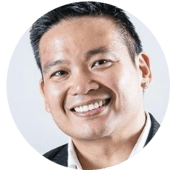

Patricia Poon
People Development Learning Institute, Asia & TWHK


Benjamin Festin
Org Design & Change Partner SEA and L&D Lead for SSC SG & MY


Sherwin Siregar
SVP & Head, Distribution Business Management

Su-Yen Wong
Founder and CEO

The COVID-19 pandemic has forced people managers to innovate, and Singapore’s HR practitioners have risen to the occasion.
But there is still a long way to go. Working models and employee expectations have changed in unexpected ways, and 2021 will see a few urgent questions that HR must address. As EngageRocket turns four, we took this opportunity to catch up with four of the industry’s eminent leaders, discussing their plans, ideas, and recommendations. At our recent event titled “PeopleFirst 2020,” we were joined by Wei-Ling Poon Patricia (People Development Learning Institute, Asia & TWHK, at Sanofi), Benjamin Festin (Org Design & Change Partner SEA and L&D Lead for SSC SG & MY at Dairy Farm Group), and Sherwin Siregar (SVP & Head, Distribution Business Management at Prudential).
As 100% WFH gradually gives way to hybrid work environments, as organizations come to terms with the new modalities of employee wellbeing, these insights can help you prepare for the road ahead.
Staying motivated, focused, and inspired at work can be difficult when the world is going through an unprecedented crisis. Employers have been tasked with not just goal-setting but also with creating an atmosphere of positivity where the workforce can thrive. This takes investment in physical wellbeing, regular communication, and a certain pragmatic agility.
Benjamin spoke about his experience at Dairy Farm of securing employee safety overnight. “Our employees are very loyal to us. We had to ask them ‘I'm not sure when this will end, but we want you to stay on to work. And if you do, we will make sure that we find accommodation and you're comfortable.’ And all that in less than 24 hours,” he said.
Since the majority of Dairy Farm’s workforce had homes in Malaysia, the HR team had to prepare hundreds of hotel rooms overnight. Once this was achieved, the company went on to reconfigure all communications through virtual channels.
Sherwin discussed the role of communication when motivating employees, and the challenges he faced at Prudential. As a financial services company, Prudential was hugely reliant on face-to-face conversations and sales meetings. “Everything that was in-person now needs to be virtual. So we switched to our IT systems, Microsoft Teams, etc., but the adoption rate was initially very low. Over time, familiarity grew and we were able to work remotely quite effectively.”
Sherwin also shared an instance of pragmatic agility and flexibility from managers that accommodated employees’ changing schedule obligations.
“The kids couldn't go to school, so you really had to be empathetic. And no two persons’ schedules are the same, so you really had to be flexible around it,” he added.
On similar lines, Patricia spoke about adapting Sanofi’s learning systems for the new normal. As a biopharmaceutical company, Sanofi’s sales representatives regularly visited doctors and hospitals – something that was no longer advisable.
“We took the opportunity to put together a lot of short training videos, keeping the workforce very nimble and on their feet. We also shared some of these training videos with healthcare providers electronically, because they cannot actually visit doctors, hospitals, and healthcare institutions during this time. So, agility was very much a big part,” she said.
Sanofi also maintained a regular line of communication to allay any fears among the workforce.
With employees working from different locations, there is a very real risk of erosion of trust. In 2020, HR must be mindful of this risk and be “intentional” about their tactics for ensuring trust, transparency, and accountability in all communication.
“For the first time, you have 100% of the workforce going remote work. We need to be very clear and communicate with employees what exactly it means to work remotely and how managers can actually engage with team members. Sanofi offered its managers coaching on this topic, which is not an easy exercise, even when you’re face-to-face. We needed to be very intentional to make our managers comfortable about remote work and conversant with its best practices. Short meetings, 30-minute 1-on-1 huddles, and frequent catch-ups, that sort of thing,” Patricia told us.
Making each and every team member accessible to their colleagues is also vital. Patricia shared an example: “There was a team member who was excellent at playing the guitar, and team members could actually submit song requests via Zoom.”
In many ways, 2020 has been a year of response and reaction to the pandemic crisis – the next few quarters will witness several of the deferred changes from this period come out of the backburner. Bit navigating them in a remote or hybrid environment can be difficult.
According to Benjamin, opportunities for change and transformation abound no matter what the circumstances are. He suggested a two-part communication strategy for realising them – getting buy-in from different stakeholders and engaging the parties who will actually influence the change.
“Dairy Farm launched a giant rebranding exercise during this period. And prior to that, we were engaged in competitive service training – change management was critical to keeping these things going. I took it upon myself, then, to lead the first few training sessions, after which the trainers got slightly more comfortable.
A big part of implementing change is also the ability to incorporate different stakeholder viewpoints seamlessly. For Patricia, this meant outlining practices for those who want to work from home most of the time, and others who might want to come into the office. “That's a very big impact on all HR professionals, thinking of the best way to have all these kinds of practices for a new work culture,” she said.
The labor force has gone through a sea change this year, compelling HR professionals to rethink how they approach talent pools.
For one thing, it has raised questions around geographic scope.
“We are seeing companies that advertising roles with the tag “remote eligible.” So, the location of the talent is not relevant. Some US multinationals may be headquartered in an office in Silicon Valley. But they will start advertising “remote eligible” roles. It doesn’t matter if the employees are in some suburb – as long as they can get the work done in a particular time zone, with the majority of the team. So, absolutely so we're going to start seeing some of these roles where a location does not need to be specified and but HR will need to spell out what does that means as well,” Patricia explained this trend in detail.
Another shift is the growing role of technology to augment job roles in the new normal.
2021 will have companies integrating people and technology in creative new ways, starting with learning management systems to gradual gamification of the entire employee experience.
“We've invested quite heavily in specific learning management systems. We can actually empower team members in short, bite-sized videos about improvement processes. It is almost like a quantum leap in terms of learning from, you know, e-learning from years ago,” Benjamin mentioned.
Technology-enabled learning is essential if businesses are to go beyond just keeping up the status quo in 2021. At Sanofi, technology helps to bring in a bit of fun when training employees for their job roles. “We always have music playing during breakout sessions. We use Kahoot! a lot to have fun quizzes and assessments. We are also exploring the idea of a virtual hackathon that engages not just your team, but the entire workforce,” said Patricia.
“Spotify is your friend,” Benjamin agreed.
It is also important for HR to be cautious when applying technology for learning content dissemination. It isn’t advisable to “bludgeon” a person with it, believes Benjamin. Instead, it is smarter to give employees free reading time and self-paced quizzes, focusing the virtual session on direct, instructor-led sessions.
As the pandemic carries on, its psychological burden and impact on mental health cannot be ignored. The time employees spend at work should not make this worse – in fact, there are several ways in which managers can look after employees’ mental wellbeing while working remotely.
“Right now, you can’t just look around and see what the general mood is like in the office,” pointed out Sherwin. “You need to have that dedicated time to check on employees, and managers aren’t really great at this. A level of individualisation and flexibility is needed, where managers/leaders empathise with an individual’s situation and its requirements. They must also be flexible enough to adapt.”
Arbitrary scheduling like no-meeting-Thursdays, four-day workweeks, etc., can actually go against individualisation as they frequently conflict with a person’s non-work obligations. Sherwin told us how he frequently sets aside meeting slots post 6 p.m., as a lot of employees feel more productive at this time.
This type of flexibility from managers is an invaluable skill when work-life balance often turns into work-life integration. “Basically I'm saying that I understand. If you need to do something for your family, and you make it work, you can come in from some street or at a crazy time – no problem,” Sherwin added.
Another useful tactic for employee wellbeing is to foster a sense of purpose through “stacking.”
Sherwin explained how Prudential holds employee events stacked with a social purpose and meaning. “If we think about the emotional outcome, we're trying to people feel more engaged, feel like “I belong to something meaningful,” he said.
Given so many trends and shifts in expectations, it can be overwhelming for HR practitioners to keep up. We asked our experts to sum up their predictions for 2021 into a few essential buzzwords.
Ultimately, it all comes down to empathy, openness, and the ability to distinguish between micromanagement and support.
As employees feel a varied range of emotions and go through a spectrum of individualised challenges, empathy is key if leaders are to adapt without causing added stress or discomfiture. This combination of empathy and openness would create an environment where employees feel psychologically safe in carrying out their jobs – even coming up with disruptive ideas – without looking back.
A big thanks to all our experts for their invaluable contributions.

 .
. 
Copyright © 2025 EngageRocket Pte Ltd. All rights reserved unless otherwise stated.